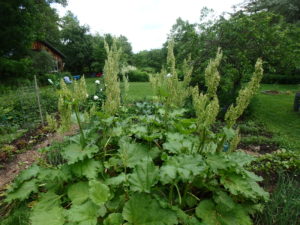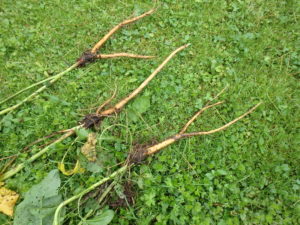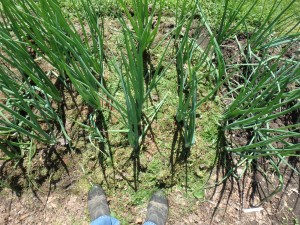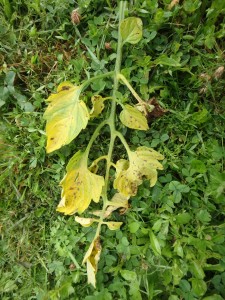5 Things You MUST DO in the Vegetable Garden This Weekend – or Soon
Okay, nobody likes to be told what they have to do. Or when they have to do it, so I apologize for telling you what to do. And you don’t really have to do these things immediately, but doing them soon will help you later on.
- It’s time to thin root crops- my least favorite task in the garden. But by now carrots, beets, parsnips and so forth need to be thinned in order for them to develop well.
- You need to put in your tomato supports to keep the plants off the ground, either tying them to stakes or surrounding them with wire cages.
- You need to hill up your potatoes if they have six to twelve inches of green growth by now.
- Cut off those tall flower spikes from your rhubarb. Quick, easy, productive.
- Weed.
Let’s take a look at each of these tasks. First, it’s important to thin root crops that are too close. I’m assuming you planted these frost hardy plants in late April or May, and they have gotten to be 3 inches or so tall by now. They’re big enough that you don’t have to wear your reading glasses to distinguish individual plants.
Carrots and beets can compete with each other just as they would have to compete with weeds. Nutrients from the soil, water, even sunshine is minimized if veggies are too close. So thin your carrots and beets to an inch apart now, and 2 to 3 inches in a month. Yes, you can get a crop without thinning, but the production is vastly reduced. And you can eat the thinnings.
Beets seeds are actually seed capsules with 2 to 3 seeds inside each one. So no matter how well you space your seeds, you will need to thin them. There are monogerm beets like ‘Moneta’ from Johnny’s Selected Seeds that only have one beet embryo per seed capsule, but those are rare. You can re-plant the thinnings, but it’s not always successful. Take a pencil, poke a hole, drop in the roots of the beet, and firm up the soil. Or you can just eat the beet greens.
When I was young and very busy raising kids, I didn’t stake up all my tomatoes. Some I let flop over and lay on piles of straw. Those on the ground suffered from diseases much more than those I caged. I now use 4-legged cages that are 54 inches tall – the biggest commercially available.
This year a friend gave me a home-made cage made from sheep fencing. The fencing is made into a 24-inch cylinder that stands 48 inches tall. Each cage needs a 6-foot grade stake to keep it from tipping over and openings that are big enough for your hand to pass through to pick tomatoes. I’ll decide if this cage is worth replicating next year.
Depending on the weather and where you garden, it may be time to hill your potatoes. This means adding soil over the planted seed potatoes. Roots go down from the seed potato, and new potatoes form above the seed potatoes. If you want lots of potatoes, there has to be room for them to grow. So adding soil from the walkways or your compost pile is essential to having enough depth for good production. Another way to do that is to pile on a thick layer of hay or straw, a technique I am trying with some of my potatoes.
Rhubarb, I have heard, is one of the last flavors to be lost by the elderly as their senses diminish. That’s why, I suppose, that homes for the elderly serve rhubarb desserts at this time of the year. It’s very easy to grow- once established there is little to do other than occasionally add some compost to the soil, or to scratch in some organic fertilizer.
By now, however, rhubarb is sending up tall shoots with white flowers to produce seeds. They are quite spectacular as flowers go – they grow as fast as Jack’s proverbial beanstalks. But like all seeds, they consume energy and minerals from the soil, so it makes sense to cut them down.
Last, but not least, you need to weed. You know that. I find that if weeding becomes a regular part of you day – like brushing your teeth or making your bed – the weeds will not overcome your garden. Even 10 or 15 minutes a day will make a huge difference.
Right now I have been concentrating on tall, deep-rooted weeds like dandelions and burdock. I find that since the soil is moist down deep, it is easier to get these weeds more easily than later in the summer when the soil is dry. I use a garden fork to loosen the soil down a foot or more, then apply even, gentle pressure pulling on the top of the plant. Most come out all in one piece. That’s good, as a broken tap root will send a new plant up later.
Never let weeds go to flower or set seeds. If nothing else, snip or pull off the flowers to keep the weeds from producing seeds. If you have particularly virulent weeds like goutweed, dispose of the flower heads in the trash going to the incinerator or land fill. Some weeds can produce viable seeds even after being pulled or having their flowers cut off.
So get busy in your vegetable garden. There’s lots to do.
Read Henry’s twice weekly blog at https://dailyuv.com/
Mid-summer Tasks in the Garden
By now my gardens are well established and most plants are doing well. But there are tasks, both in the vegetable garden and in the flower beds, that need my attention.
Weeding is key in both areas, and recent rains make doing so easier as the soil has softened up. If you have very dry soil where you are, you might want to water well before weeding.
Why worry about weeds? I know gardeners who don’t do much weeding in their vegetable gardens. One even told me that if he weeded too much the deer would find his vegetables! But weeds anywhere in the garden are going to spread seeds soon – whether in the walkways or up close to your tomatoes. And seeds will come back to make more work now – and in the years to come. Many weed seeds act like time release capsules, some germinating now, some later, some 5 years down the road.
Weeds compete with your plants for moisture, soil nutrients – and even sunshine as they get bigger. I use a CobraHead hand weeder (www.CobraHead.com). It’s shaped a bit like a curved finger with a sharp pointy spade-shaped tip about an inch across. It easily gets under weeds so that I can pull from above (with one hand) and from below (with the CobraHead) at the same time, or tease long roots out of the soil without breaking them.
Thinning your carrots, beets and other root crops is an urgent job if you haven’t done so yet. Like weeds, vegetables growing too close to one another will compete for sun, water and nutrients. Carrots and beets should be at least an inch apart by now. And in a month, you need to thin them to 2 inches apart. Pulling the sharp tip of a CobraHead alongside a row of carrots will loosen the soil, sever a few side-growing roots, encouraging those that go deep. And scratch in some organic fertilizer now, too. It will help you get bigger carrots.
By the way, you can transplant carrots as you thin them out. Poke a hole deep enough so that the carrot will not bend, drop it in, press down the soil, water. It’s not a 100% reliable technique, but I hate to kill plants and have found it works most of the time. Do it in the evening, so they will have all night to recover before the hot sun hits them.
My onion patch was recently weeded, but I know that weeds will be along soon. So I mulched my onions with grass clippings. I find they work better than straw or hay in tight quarters like the onions. And green clippings may add a little nitrogen to the soil as they break down.
In many gardens the lower leaves of tomatoes are starting to yellow and develop dark blotches, sure signs of early blight. Although this blight is not immediately fatal, it reduces crop yield. By the end of August stems are often bare of leaves. You can minimize it by pruning off the affected leaves and all lower branches that touch the soil or are near it. Work on your plants when they are fully dry as the disease spreads more easily when leaves are wet.
I use scissors to remove the leaves, dipping them frequently in a glass of rubbing alcohol to sterilize them between plants. I wash my hands in a bucket of soapy water between plants. To see an in-depth article about this procedure along with many pictures, go to https://dailyuv.com/news/
I always plant my potatoes in June, even though many gardeners start planting them in April. I do this as I ‘ve found that I have fewer potato beetles by planting late. Maybe they’re all at my neighbors’ gardens. But do take some time to check yours to see if any beetles are eating the leaves. Look for larvae, and for orange egg masses on the underside of leaves.
When you plant your potatoes the roots will grow down below the seed potatoes and the new potatoes will form above them. Now is a good time to add soil over the developing potatoes. This is known as hilling them. I plant mine using a post hole digger, so it’s easy to fill in above my seed potatoes, just pushing the soil from mounds next to each plant. You can also use a hoe and scrape soil from the walkways. Don’t worry if some leaves get buried. They won’t complain.
In my flower gardens I am mainly weeding and cutting back flowers stems that have already blossomed. Weeding gives me space to plant new flowers – even though I have an extensive palette of plants, I constantly go to garden centers to see new things, or plants I once had that have disappeared. (Yes, I kill a lot of plants, we all do).
Cutting off spent flowers is good. Important. It takes a lot of energy to produce seeds. By pruning back the spent flowers, your plants have more energy to develop good roots and strong stems.
So get outside and enjoy summer and pull some weeds. You garden will look better and you’ll feel better, too.
Henry is a UNH Master Gardener and the author of 4gardening books. His website is www.Gardening-Guy.com. Read his twice-weekly blog athttps://dailyuv.com/







